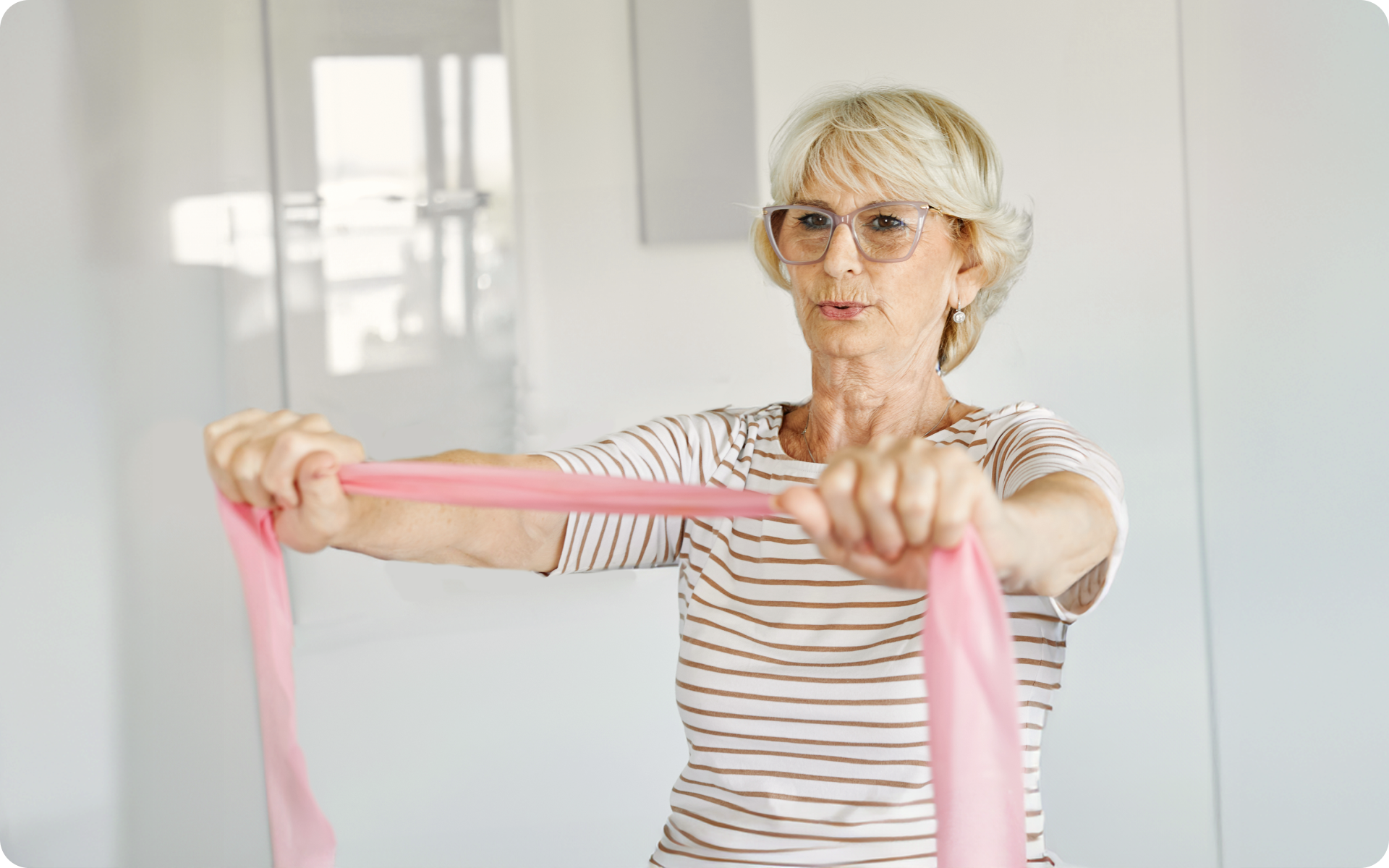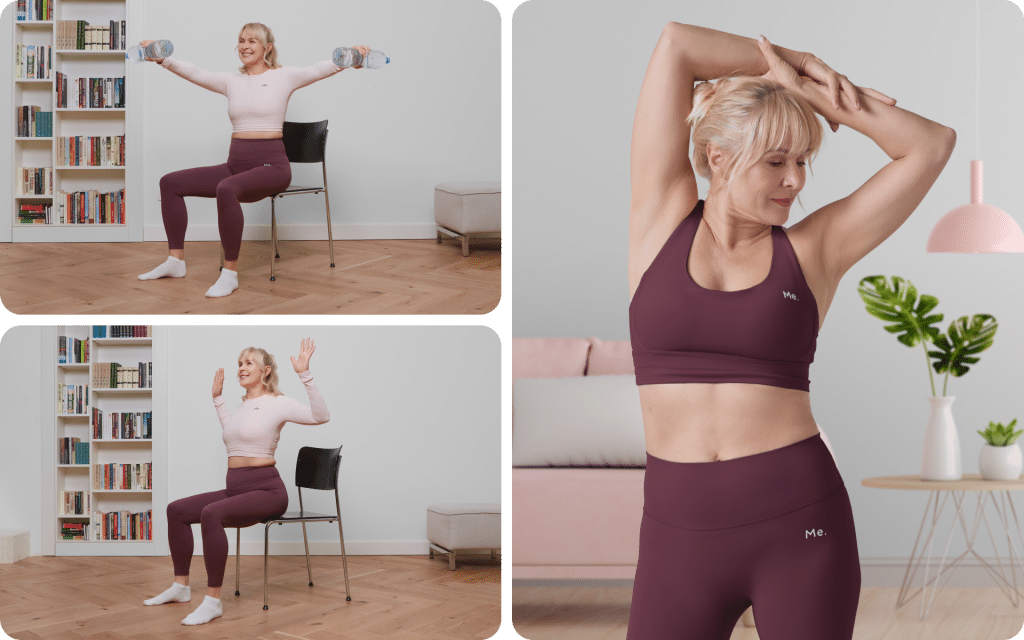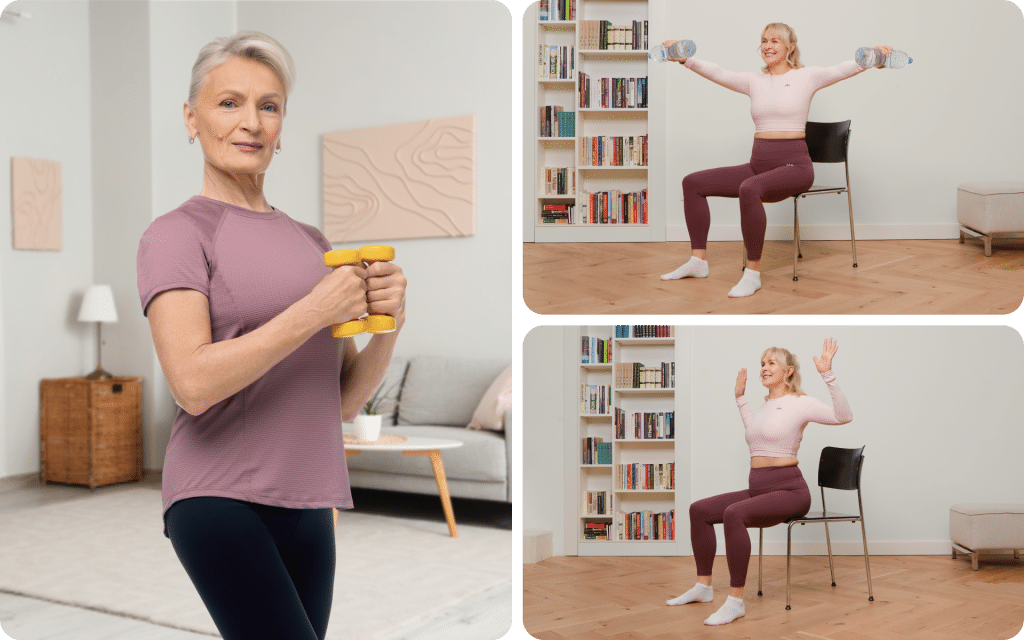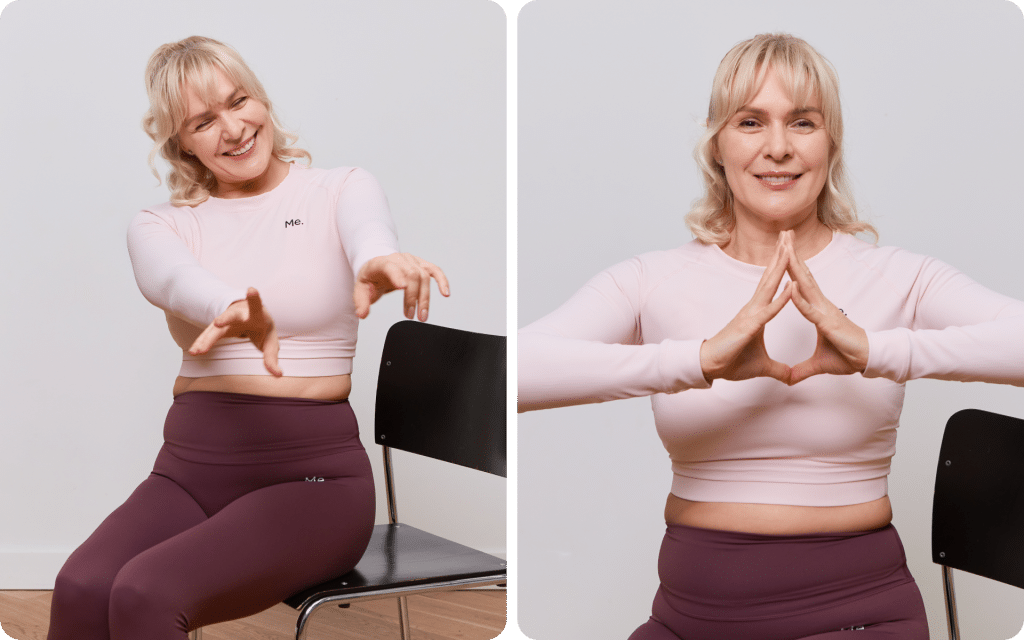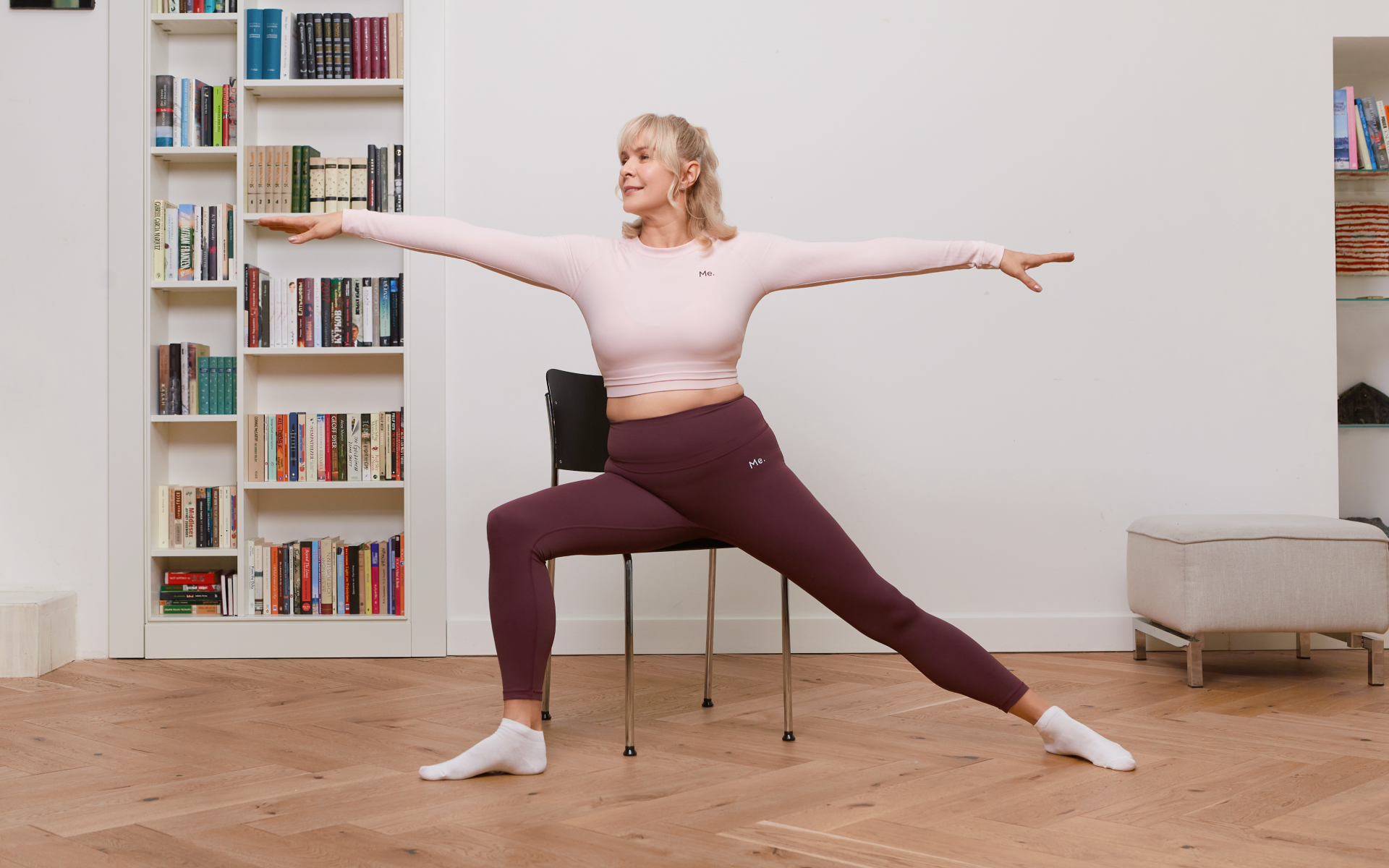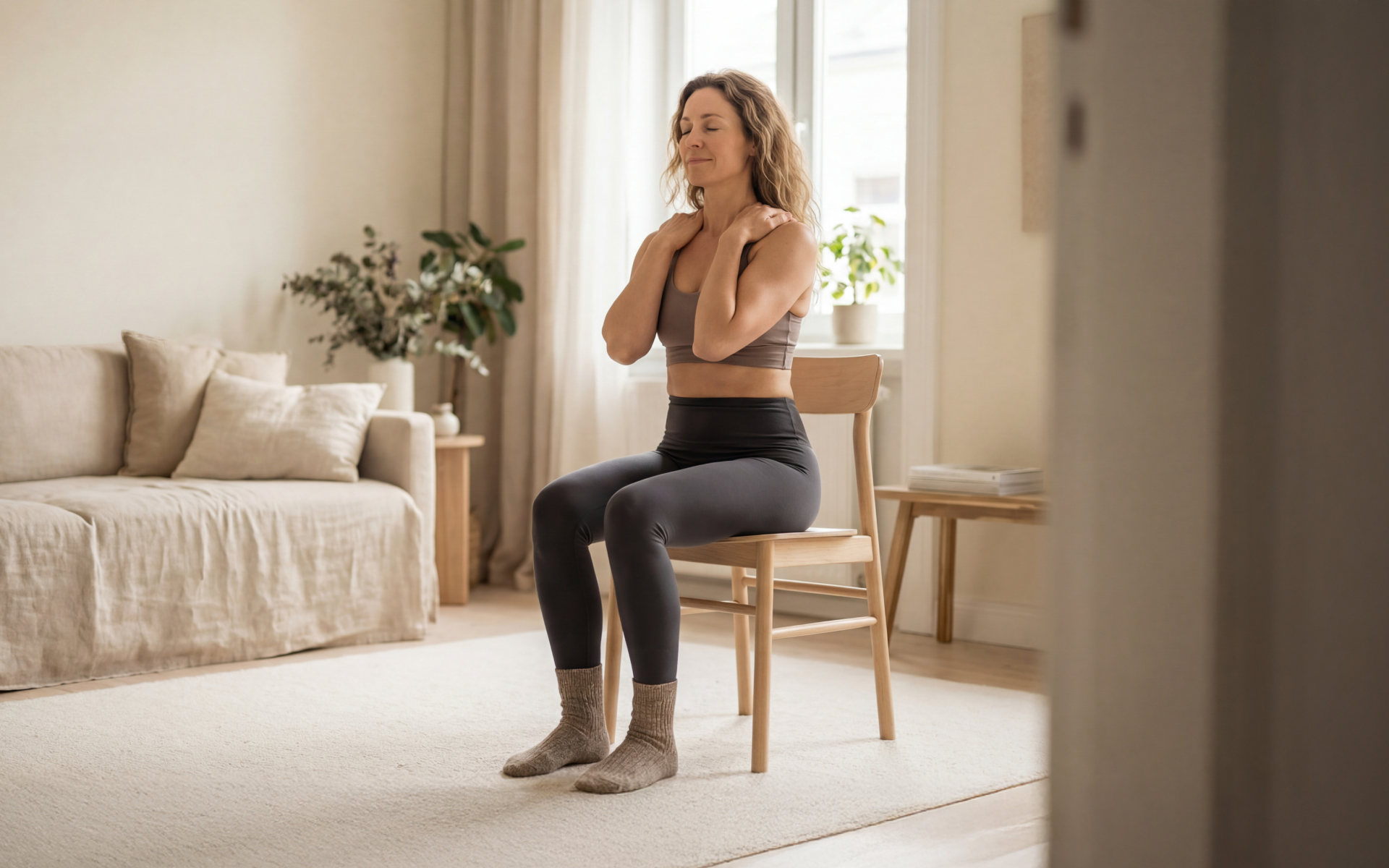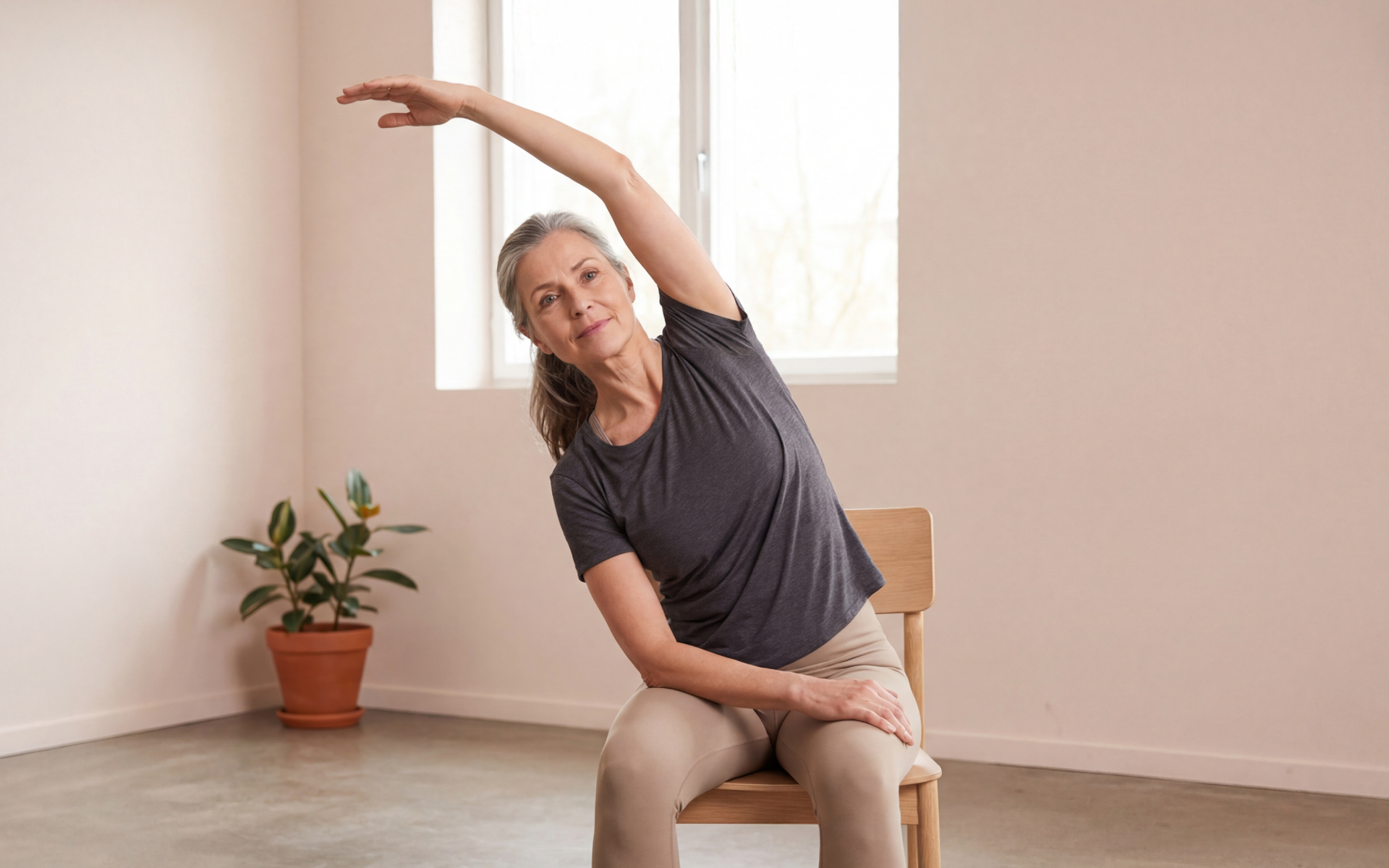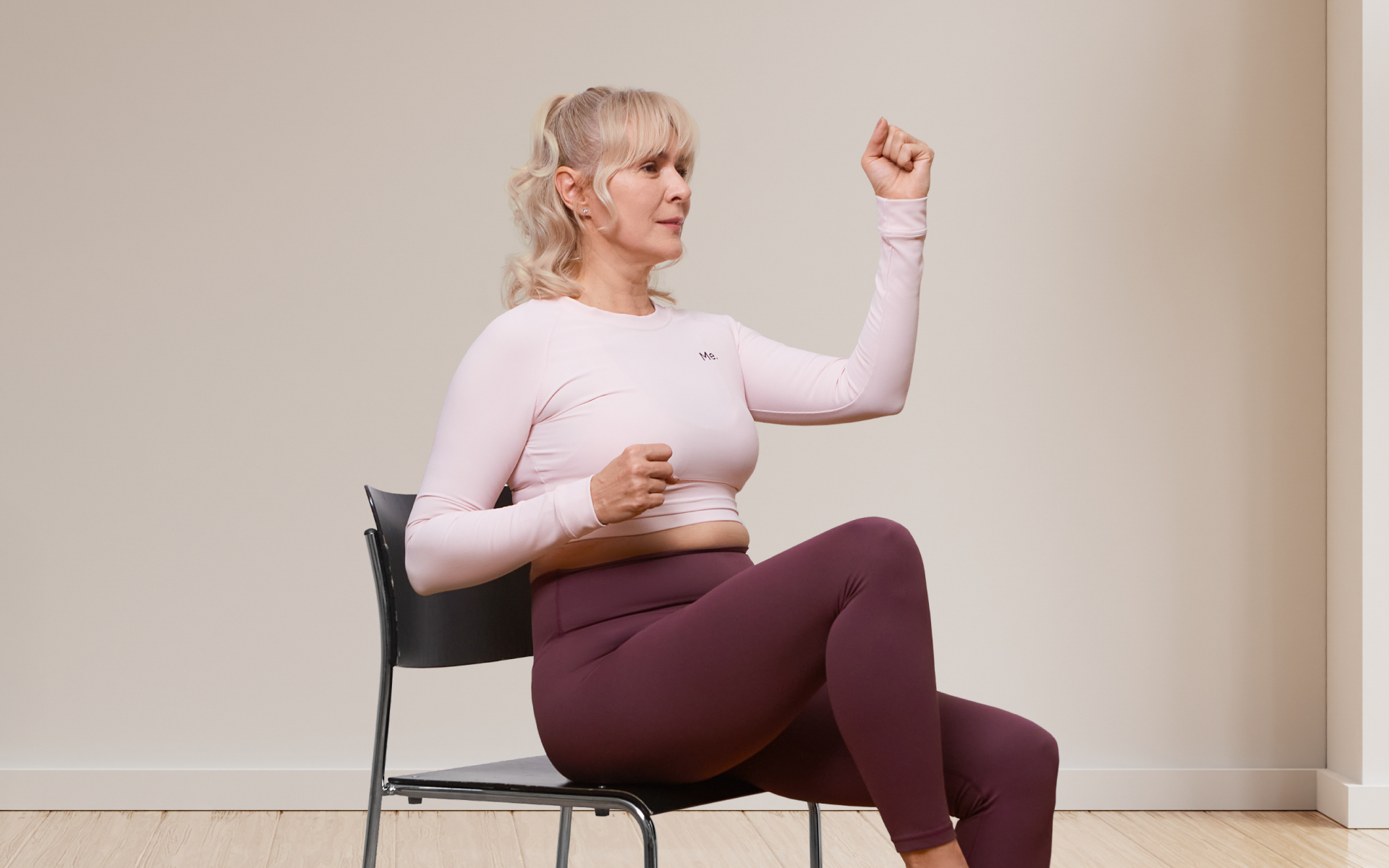Chair yoga for elderly people is an increasingly popular way to support mobility, flexibility, and overall well-being without the strain of traditional exercise.
With smooth and gentle movements that are tailored to various fitness levels, senior chair yoga provides a safe and inclusive approach to staying active, even for individuals who have balance issues or limited mobility.
In this article, we’ll explore the benefits of incorporating chair exercises for elderly people into a routine, the recommended frequency of these exercises, and the best app for learning chair yoga.
What Is Gentle Chair Yoga for the Elderly?
Gentle chair yoga is a modified variation of traditional yoga. These modified chair yoga poses for seniors are done while seated on or standing by a chair, preferably one without wheels. Research over the years has shown that this workout enables the elderly to increase their muscle endurance, flexibility, functional fitness, and significantly improve their quality of life (1, 2).
What Is the Best Yoga for the Elderly?
For the elderly, chair yoga is usually considered the best option due to the following factors:
-
Accessibility
Elderly people are usually unable or reluctant to exercise due to physical limitations such as chronic pain and fear of injury, in addition to environmental barriers such as a lack of suitable programs and unsafe exercise environments.
Traditional standing yoga exercises are largely inaccessible to seniors, as many of the poses may trigger their fear of falling/injury and cause pain in their joints. In addition, the difficulty of these asanas may make them lose the enthusiasm and motivation to try the exercise.
However, chair yoga exercises for seniors are specifically tailored with the fears and limitations of older adults in mind, which makes this variation more accessible and increases the chances that seniors will be interested in it and be able to do said exercises with little to no discomfort or pain.
-
It’s a Low-Impact Exercise
Many older adults are unable to engage in high-impact workouts due to age-related conditions such as sarcopenia, bone density loss, and joint issues, all of which result in increased fragility, pain, swelling, and reduced mobility (3, 4, 5).
Chair exercises for seniors, in addition to other low-impact workouts such as Pilates, allow older adults to engage in exercise despite any of the above-listed problems.
Not only are such workouts safe and easy for their fragile bones, muscles, and joints, but with consistency, over time, these workouts could help improve these conditions, thereby improving their pain management and quality of life.
BetterMe will shake off your mental funk, rid you of your energy-zapping habits, and help you sculpt the body of your dreams. Intrigued? Hurry up and change your life for the better!
-
It’s an Adaptive Exercise
Adaptive workouts refer to the modification of physical exercises to make them more accessible to those with disabilities or physical limitations. As previously explained, chair yoga is a modified version of traditional yoga that makes the exercise more accessible to the elderly.
Note that if a senior still finds some chair yoga poses difficult to do, a trained professional can work with them to further modify the poses to make them easier to complete.
Read more: 10 Chair Yoga Ideas for Beginners
Does Chair Yoga Really Work for Seniors?
Yes, it does. A common myth in the fitness community is that modified versions of an exercise aren’t as effective as the original. This couldn’t be further from the truth. Easier doesn’t necessarily mean less effective. Here’s some proof of the effectiveness and benefits of chair yoga:
- Improved Functional Fitness
Due to a sedentary lifestyle and the age-related illnesses mentioned above, older adults may find it difficult to engage in simple everyday activities such as walking, lifting things, bending over, and sitting down. Research has shown that performing chair yoga can help improve functional fitness, which makes these activities easier to do (2).
- Improved Muscle Strength
Age-related muscle loss and a sedentary lifestyle will lead to reduced muscle strength. This then causes decreased independence, increased risk of falls and fractures, and a decline in overall quality of life in seniors. Luckily, research has shown that chair yoga can improve muscle strength in the upper and lower body, which could help them reclaim their independence and improve their quality of life (6).
- Improved Brain Health and Cognitive Function
Brain-related issues such as memory loss, dementia, stroke, depression, and other conditions are common in adults. While they can be a result of injuries to the brain, mood disorders such as depression, substance use or addiction, or illness, some of them are brought on simply by the fact that we are aging (7, 8).
Research has shown that both aerobic and resistance training exercises can help improve the cognitive function of older adults, regardless of their mental state (9). Chair yoga is both a balance exercise and a form of resistance training exercise that has been specifically shown to improve memory retention and adherence (10).
Whether you’re a workout beast or just a beginner making your first foray into the world of fitness and dieting – BetterMe has a lot to offer to both newbies and experts! Install the app and experience the versatility first-hand!
- Improved Balance
The loss or lack of balance is one of the main reasons why many older adults rarely engage in exercise. Not only does the lack of balance increase the risk of falls, but because they have weaker bones, it also increases the risk of breaking them. Fortunately, studies over the years have shown that chair yoga can improve balance, which reduces the risk of falls, injury, and fractures (6, 11)
- Additional Benefits
Studies have also shown that chair yoga for elderly people can help improve their muscular strength, management of chronic pain, mobility, range of motion, and much more (12, 13, 14).
What Is a Gentle Chair Yoga Elderly Workout?
A gentle chair yoga elderly workout is a modified form of yoga that is designed specifically for older adults to allow them to practice this exercise while seated or standing and using a chair for support. Unlike traditional yoga, this variation is ideal for those with limited mobility, balance problems/concerns, or joint stiffness.
Many of the moves in this variation are focused on slow, controlled stretches, breathing exercises, and light strengthening movements, all of which are designed to improve flexibility, circulation, and relaxation. With time and consistency, older adults will start seeing the benefits mentioned in the section above.
Check out this article to learn more about gentle chair yoga for beginners and seniors.
How Many Times a Week Should a Senior Do Chair Yoga?
Chair yoga is a low-impact workout that can be done up to 6 days a week with minimal side effects. However, seniors, especially beginners, should aim for 2-4 days to start.
This frequency will give them enough time to rest between weekly workouts, which will allow their bodies and muscles to adjust to this new physical routine. After a few weeks of this, they can decide whether to increase the frequency depending on how their bodies feel and recover after the workouts.
Read more: Seated Chair Yoga for Seniors: A Complete Guide to Safe Movement
Which Is the Best Chair Yoga App for Seniors?
We believe that you’ll find the best chair yoga for elderly people routine on the BetterMe app. The app has a 28-day chair yoga program that is specially designed for seniors to help improve flexibility, build strength, and improve their overall well-being.
The routine takes into account the challenges seniors face when performing yoga and provides guided weekly exercises that help the user learn and master basic poses and alignment.
This program is also designed in a way that constantly challenges your balance, strength, and flexibility to help you gradually get better, and it gives you encouragement that keeps you going while also celebrating your small wins and progress.
While chair yoga is largely used by seniors, it’s suitable for all age groups. People with limited mobility, those who are recovering from injuries, and even office workers can use this gentle exercise to manage pain and improve their flexibility, muscle strength, relaxation, sleep quality, and balance (15, 16, 17). However, it’s important to remember that it’s always essential to contact a medical professional before you get started on any new exercise program. Neither option is necessarily better than the other. Both options are low-impact and can be adapted to suit any fitness level or physical limitations you may have. Choose the option that is easily accessible to you and that fits best in your routine. If you can, we would suggest adding both yoga and Pilates to your weekly routine for variation and better benefits. As previously mentioned, chair yoga is gentle and low-impact enough that it can be done daily with minimal negative effects. However, just to be on the safe side and prevent overtraining the body and muscles (18), we recommend performing chair yoga workouts 5 or 6 days a week at most. This allows the muscles 24 to 48 continuous hours of rest to rest, recover, and get ready for the next workouts. Yes, you can. Despite being a gentler modified version of yoga, chair yoga is still a physical activity, which means it burns calories. The calorie burn may not be as high as high-intensity workouts, but it’s better than not burning any due to leading a sedentary lifestyle. So yes, consistently performing chair yoga exercises can help with weight loss, particularly when combined with a healthy calorie deficit diet and other workouts such as Pilates, water aerobics, light weight training, and walking.Frequently Asked Questions
What age group is chair yoga for?
Is yoga or Pilates better for seniors?
Is it OK to do chair yoga every day?
Can you lose weight doing chair yoga?
The Bottom Line
Chair yoga for the elderly is a good workout option that helps them lose weight, increase balance, muscle strength, cognitive function, and improve bone density, all of which are factors that will increase their independence and quality of life. All seniors should be encouraged to engage in exercise, and chair yoga is a great starting point. If you’re unsure how to train them on this workout, the BetterMe app offers a simple routine that all older people can use.
DISCLAIMER:
This article is intended for general informational purposes only and does not serve to address individual circumstances. It is not a substitute for professional advice or help and should not be relied on for making any kind of decision-making. Any action taken as a direct or indirect result of the information in this article is entirely at your own risk and is your sole responsibility.
BetterMe, its content staff, and its medical advisors accept no responsibility for inaccuracies, errors, misstatements, inconsistencies, or omissions and specifically disclaim any liability, loss or risk, personal, professional or otherwise, which may be incurred as a consequence, directly or indirectly, of the use and/or application of any content.
You should always seek the advice of your physician or other qualified health provider with any questions you may have regarding a medical condition or your specific situation. Never disregard professional medical advice or delay seeking it because of BetterMe content. If you suspect or think you may have a medical emergency, call your doctor.
SOURCES:
- The Effectiveness of Chair Yoga in Older Adults: A Literature Review (2023, researchgate.net)
- Effect of Chair Yoga Therapy on Functional Fitness and Daily Life Activities among Older Female Adults with Knee Osteoarthritis in Taiwan: A Quasi-Experimental Study (2023, pmc.ncbi.nlm.nih.gov)
- Age-Related Changes in the Musculoskeletal System and the Development of Osteoarthritis (2011, pmc.ncbi.nlm.nih.gov)
- Low bone density and osteoporosis among older adults with Alzheimer’s disease, vascular dementia, and mixed dementia: A Cross-sectional Study With Prospective Enrollment (2020, pmc.ncbi.nlm.nih.gov)
- The age-related loss of skeletal muscle mass and function: Measurement and physiology of muscle fibre atrophy and muscle fibre loss in humans (2018, pmc.ncbi.nlm.nih.gov)
- Effectiveness of Chair Yoga for Improving the Functional Fitness and Well-being of Female Community-Dwelling Older Adults With Low Physical Activities (2019, journals.lww.com)
- Memory Problems, Forgetfulness, and Aging (2023, nia.nih.gov)
- Cognitive Health and Older Adults (2024, nia.nih.gov)
- The Effects of Exercise for Cognitive Function in Older Adults: A Systematic Review and Meta-Analysis of Randomized Controlled Trials (2023, pmc.ncbi.nlm.nih.gov)
- Remotely supervised home-based online chair yoga intervention for older adults with dementia: Feasibility study (2022, pubmed.ncbi.nlm.nih.gov)
- Safety and feasibility of modified chair-yoga on functional outcome among elderly at risk for falls (2012, pmc.ncbi.nlm.nih.gov)
- A Pilot Randomized Controlled Trial of the Effects of Chair Yoga on Pain and Physical Function Among Community-Dwelling Older Adults With Lower Extremity Osteoarthritis (2016, agsjournals.onlinelibrary.wiley.com)
- Yoga for Healthy Aging: Science or Hype? (2021, pmc.ncbi.nlm.nih.gov)
- Perceptions and experiences of chair-based yoga by older adults with multimorbidity – a qualitative process evaluation of the Gentle Years Yoga randomised controlled trial (2025, bmcgeriatr.biomedcentral.com)
- Fifteen Minutes of Chair-Based Yoga Postures or Guided Meditation Performed in the Office Can Elicit a Relaxation Response (2012, pmc.ncbi.nlm.nih.gov)
- A Study Of The Effectiveness Of Chair Yoga For The White -Collar Employees Of Education Sector (2021, researchgate.net)
- Effect of chair yoga on heart rate variability, perceived stress, and sleep quality among nursing professionals from a tertiary care hospital (2023, researchgate.net)
- Overtraining Syndrome (2012, pmc.ncbi.nlm.nih.gov)
